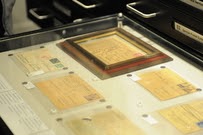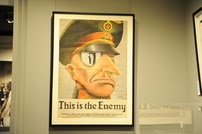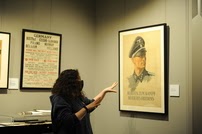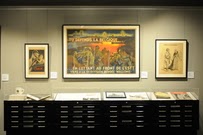An Exploration of the Bronx Science Holocaust Museum
Bronx Science has many unique courses and opportunities on offer, including a very important one, the ‘Holocaust Leadership’ class. The Bronx Science Holocaust Museum and Studies Center is a valuable part of Bronx Science that all students should visit and experience.

Here is a case in the Holocaust Museum of postcards and letters from the World War II era.
According to the American Jewish Committee, one in four American Jewish individuals said that they have faced Antisemitism in the last twelve months. Antisemitism — defined by the Meriam Webster Dictionary as the “hostility toward or discrimination against Jewish people as a religious, ethnic, or racial group” — has been steadily rising in the past few years. Now, more than ever, it is important to learn about Jewish history and the tragedy of the Holocaust.
Luckily, Bronx Science has an entire course dedicated to the Holocaust and an impressive Holocaust Museum and Studies Center. Officially named “Holocaust Leadership,” the course was initiated in 1978 when Dr. Stuart Elenko, a Bronx Science history teacher, sought to fill the hole in history education at Bronx Science. Previously, no Bronx Science history class covered the Holocaust. Elizabeth MacEnulty, the current Holocaust Leadership teacher, cites the time period as the reason for the lack of Holocaust education. She said, “It was too recent. It was only 30 years ago at that point.” Many Bronx Science students at the time were children of Holocaust survivors and refugees, and were desperate to learn about their own history.
The course and the museum were developed together. Ms. MacEnulty said, “He [Dr. Stuart Elenko] started the collection by having some students bring in personal artifacts, and then he started raising money and purchasing things at auctions.” The collection lived in the library’s multipurpose room before the current, beautiful, and impressive official Holocaust Museum was built in Spring 2013 in the basement. The renovation of this part of the basement had a 1.2 million dollar budget thanks to the school’s endowment as well as support from private donors such as the Claire Friedlander Family Foundation.

The Holocaust Museum’s collection is one of a kind. It has over 1000 unique artifacts including military uniforms, Jewish star patches, and ghetto money. When Ms. MacEnulty passionately discussed the museum’s collection of propaganda posters, she said, “It’s actually very unique to have as many propaganda posters from as many perspectives as we do, all in one collection.” Since the museum is within a high school, very few people have access to it. However, Ms. MacEnulty is working on developing a website displaying the collection so it can be appreciated by everyone outside of Bronx Science.
Fortunately, every Bronx Science student gets the chance in their sophomore and junior year to visit the museum and receive a tour. Students are given tours of the Holocaust Museum when they cover the Holocaust during their history classes. Students receive tours from their highly-trained peers in the Holocaust Leadership course. The course not only prepares students to give tours of the Holocaust Museum, but also provides an in-depth education of the genocide from a discussion-focused curriculum. Though the museum would open to the entire school for special exhibits before the COVID-19 pandemic, currently students receive tours through their history classes, in order to follow social distancing protocols.

Ms. MacEnulty believes that the Holocaust Leadership course is perfect for students who have a “vested interest” in the Holocaust. She looks for mature students who are strong public speakers and are excited to participate in class discussions. Similar to the Journalism and Debate Leadership courses, a student can take Holocaust Leadership for up to three years — from their sophomore year through their senior year. The more experienced students train the new generation of Holocaust Leadership students on how to give interesting and informative tours of the museum.
Recent studies have found that knowledge of the Holocaust in America is shockingly low. The Pew Research Center found that fewer than half of American adults were able to answer simple questions about the Holocaust correctly, such as the number of Jewish people who died or how Adolf Hitler came to power. Ms. MacEnulty also thinks that the current political landscape in America demonstrates how uneducated some in the nation are regarding the Holocaust. She said, “I get incredibly angry when I see people comparing masks or vaccine mandates to the Holocaust. To me, this demonstrates that there is not a lot of knowledge about the Holocaust.” While the Holocaust Leadership course has always been important, recent data suggests that more emphasis on Holocaust education is imperative.

Rising Anti-Semitism and alarmingly low rates of necessary knowledge regarding the Holocaust amongst the American public are quite troubling, but Bronx Science is doing its part to educate students and the public alike. According to the same Pew Research study, American adults who had visited a Holocaust memorial or museum answered, on average, one more question about the Holocaust correctly than those who had not. The Bronx Science Holocaust Museum, with its forthcoming website and increasing number of students visiting, is making a difference in knowledge about the Holocaust for the next generation.
When Ms. MacEnulty discussed the museum’s collection of propaganda posters, she said, “It’s actually very unique to have as many propaganda posters from as many perspectives as we do, all in one collection.”
Kate Hankin is an Editor-in-Chief for ‘The Science Survey.’ In her journalistic writing, Kate likes to share her interests such as food, music, current...
Krittika Chowdhury is a Copy Chief and Chief Graphic Designer for ‘The Observatory’ yearbook and a Staff Reporter for 'The Science Survey.' Outside...
Isha Ray is a Chief Graphic Designer and People Section Editor for 'The Observatory' yearbook and a Staff Reporter for 'The Science Survey' newspaper....
